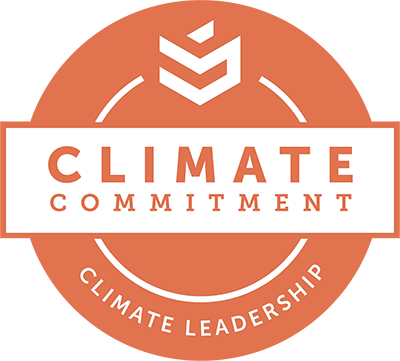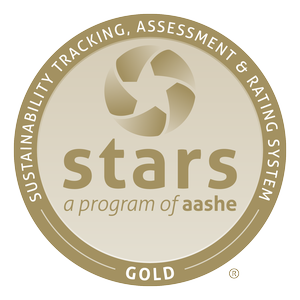Chico State 2021 Climate Action and Resilience Plan (PDF) 2021 Strategic Energy Master Plan (PDF)
Chico State is committed to achieving carbon neutrality by 2030 for scopes 1, 2, and 3 greenhouse gas (GHG) emissions and has made campus-community resilience a university-wide strategic priority.
- Scope 1 - direct emissions from processes and equipment under the ownership and control of the campus: mobile combustion in vehicles and yard equipment, stationary combustion in boilers and backup generators, release of refrigerants, and agricultural emissions.
- Scope 2 - indirect emissions associated with the generation, transmission, and delivery of purchased electricity.
- Scope 3 - indirect emissions that contribute to campus operations, but not directly owned or operated: student, faculty, and staff commuting to/from campus; university sponsored travel; wastewater treatment; and solid waste to landfill.
 Chico State first made a commitment to carbon neutrality in 2006 with the signing of the Presidents’ Climate Commitment (PDF). President Hutchinson reaffirmed this commitment in 2016 and added climate resilience to our carbon commitment. In fall 2019, the University Strategic Plan, 2019-2024(opens in new window), was released identifying Resilient and Sustainable Systems as a key strategic priority for Chico State.
Chico State first made a commitment to carbon neutrality in 2006 with the signing of the Presidents’ Climate Commitment (PDF). President Hutchinson reaffirmed this commitment in 2016 and added climate resilience to our carbon commitment. In fall 2019, the University Strategic Plan, 2019-2024(opens in new window), was released identifying Resilient and Sustainable Systems as a key strategic priority for Chico State.
Chico State publicly reports GHG emissions to Second Nature(opens in new window) and is committed to providing progress reports. The campus’ first Climate Action Plan (PDF) was adopted in 2011 and outlined 10 key steps to begin to reduce emissions. Five of these actions were completed including using a more climate-friendly power supply, retrofitting campus lighting systems, and virtualizing servers. Four actions were partially completed and one action, reducing single-occupancy vehicle traffic to campus, saw little action.
Chico State uses a 1990 GHG baseline of 32,224 metric tons of carbon dioxide equivalents (MTCO2e). In fiscal year 2017/18, Chico State reports 21,017 MTCO2e GHG emissions, a 34.8% decrease from the 1990 baseline. While this is significant, there have been minimal operational actions to get to this level with scope 1 emissions remaining relatively flat. Scope 2 emissions saw the most substantial reduction in emissions due to a switch in how campus energy was procured - switching in 2009 from buying direct access coal-generated power to purchasing power from the local utility Pacific Gas & Electric (PG&E). In 2018, PG&E sourced 39% of their power from renewable sources(opens in new window). Chico State was an early mover in shifting away from coal-based power generation but this shift must happen at a global scale, and quickly, if the most destructive impacts of climate change are to be avoided.
There is a lot of work to be done to achieve carbon neutrality by 2030 and build a campus that is resilient to the impacts of climate change that we are already experiencing. The updated Climate Action and Resilience Plan (PDF) outlines a path to achieve these ambitious goals and calls on all campus members – students, faculty, staff, and partners – to act. Further, we must remain committed to our academic mission of educating and empowering the next generation of sustainability leaders; we must build robust relationships within our community and support one another through the challenges ahead; and we must acknowledge that social justice is inextricably linked to climate justice and actively take steps to ensure a just transition to a sustainable future.
The plan calls for reevaluation in how Chico State's emissions are quantified and consideration for how additional sources can be measured and included in our inventory. The plan calls on us to not only invest in drawing down emissions, but to ensure that we are preparing for the impacts of climate change we cannot avoid. The plan identifies several pathways and ideas to draw down emissions including energy efficiency measures, electrification of university utilities, electric vehicle and equipment adoption, renewable energy additions, alternative transportation improvements, and policies and procedures that should be adopted or explored. Also identified in the plan are campus generated sources of carbon sequestration that must be supported and researched. One of the difficult challenges we will face is funding the work that must be done so the plan also outlines a few ideas to secure the financial resources necessary.
What we do today - the actions we take and the decisions we make - will decide what world we live in tomorrow.

 In May 2014, the CSU Board of Trustees adopted the first
In May 2014, the CSU Board of Trustees adopted the first  The Association for the Advancement of Sustainability in Higher Education's (AASHE)
The Association for the Advancement of Sustainability in Higher Education's (AASHE)